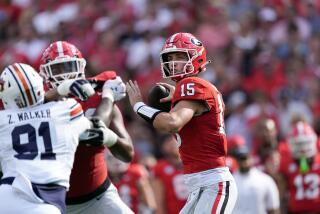NCAA Reform Would De-Emphasize Pay-for-Play : Revenue distribution: Smaller schools, however, say the rich conferences will simply get richer from $1-billion TV contract.
Executives at CBS could be excused for their lack of foresight.
A few years back they turned down a deal giving them rights to the NCAA basketball tournament at no cost.
Walter Byers, then-NCAA executive director, offered to throw in basketball if the network accepted a deal to televise five other championships in 1972.
But a lot has changed during 18 years and 769 tournament games since then.
Last year, when NCAA officials peddled its tournament, CBS offered top dollar. The tournament that once could not be given away commanded a $1 billion, seven-year package, or about $143 million annually.
All that money left NCAA administrators with the challenge of distributing it equitably among 293 Division I members. They devised a complicated formula to disburse $69.9 million of television revenues this season.
--Division I schools would share $31.25 million based on the performance of a conference in the NCAA tournament in the last six years, including this season. The conferences would determine how to distribute shares to members.
--Another $31.25 million would be shared based on how many sports schools sponsor and on how many grants-in-aid they award.
A small athletic program sponsoring the minimum 12 sports and offering 27 grants-in-aid would receive $2,350, according to calculations reported by NCAA News. An average-sized program with 20 sports and 66 grants-in-aid would get $61,700. A large program--29 sports and 268 grants--would receive $450,000.
Those figures only include the second part of the plan, which stipulates one-third of the $31.25 million for sports and two-thirds for grants-in-aids.
--Each school would receive $25,000 for programs designed to help student-athletes.
Proponents of the overall formula say this distribution of television revenue moves tournament teams away from playing for dollars.
As Dick Schultz, NCAA executive director, is fond of saying: “This takes away the $300,000 free throw.”
Schultz believes the proposed reforms will go a long way toward controlling the beast that is intercollegiate athletics.
For some time college basketball coaches have complained that athletic directors budgeted tournament receipts before the season. Earning a tournament berth often was the difference between profit and loss.
Others contend the work of an NCAA ad hoc committee in charge of finding new ways to apportion the funds has not gone far enough.
“When it is all done, they (the big-time basketball conferences) expect to get two-thirds of the revenue, and they don’t want anything less,” said Jeffrey Orleans, executive director of Ivy League schools.
“What I find frustrating is that the process is being portrayed as finding an equitable formula, but it really is about a certain small group who wants its certain share.”
A breakdown shows the major basketball leagues, such as the Atlantic Coast Conference, the Big East and the Big Ten, receive the largest portions. Payments to independents such as Notre Dame will be based on tournament performance.
James Delany, Big Ten commissioner, said some basketball powers wanted the system of rewarding schools on number of victories to be maintained.
“I think there were some real sacrifices made from major conferences,” Delany said. “It is not normal in governences of any kind to see groups voluntarily give it away.”
The issues have been debated by committee members, who will make their recommendations to the NCAA executive committee for a Dec. 3 vote.
Most athletic administrators queried said they favored the plan.
Here are a few reasons why:
--A portion of the money would fund catastrophic health insurance for athletes in all three NCAA divisions. Currently only Division I men’s and women’s basketball players are fully funded.
--Funding of food and lodging would increase for participants in Division II and III championships. In the past they often lost money traveling to championships.
--A special emergency fund will be established for needy Division I athletes.
Schultz said a majority of schools are getting more than ever without added commitment.
“I think they achieved an intelligent approach,” said Tom Hansen, commissioner of the Pacific 10. “I think they have done what is good for all its members--spread it across Division I as much as possible while keeping in mind the most broad-based and worthy programs.”
Schultz said the committee was mindful of the schools that built the tournament into a billion-dollar business while doling out more for small-time programs.
Orleans of the Ivy League said the plan is better than the present system, but questions the sincerity to reform.
He said the ratio of rewarding grants-in-aid needs revising if the plan is be truly equitable. Grant-in-aid revenue comes from a broad-based pool of $31.25 million, and is the most contentious segment of the plan.
Schools with up to 50 grants receive $87 per grant. From there, the ratio increases exponentially. Grants 51 to 100 are worth $174 each. Grants 101-150 are $870 each, 151-200 are $1,740 each, 201-250 are $2,610 each, 251 and above are $3,480 each.
Orleans said the formula emphasizes grants-in-aid at the expense of other elements of athletic programs such as coaching, improved facilities and adding sports.
The Ivy League has a special reason to complain: it does not offer athletic scholarships.
Hansen thinks such criticism is unfair.
“There are also Harvard endowments that are not taken into account,” he said. “You can carry these things on forever without an answer.”
Sam Magill, president of Monmouth College of New Jersey, argued for a flat scholarship rate instead of the sliding scale. He said every grant-in-aid should be worth $87.
Magill said Monmouth’s league, the Eastern College Athletic Conference, would receive an average of about $80,000 per school for grants. He said the ACC averages $792,000 per school.
“You call that equitable?” he asked. “I just think the disparity between rich and poor is so great it is laughable.”
Football schools stand to benefit the most from the new plan. Because of the numbers it takes to field a team, those programs have more scholarships to offer.
“I would prefer that (this formula) was not skewed to I-A football,” Orleans said.
In many cases, schools in the best basketball conferences also have football teams.
As a result, the Big Ten is projected to receive the most of the $69.9 million, with a share of $7,111,980. The Atlantic Coast Conference is second at $6,336,378. The Pac-10 is sixth at $3,959,766.
Hanson said Pac-10 schools have only themselves to blame. The conference will earn about $1.3 million from the tournament pool because of poor past performance. By comparison, the ACC will receive about $3.96 million.
“The committee never tried to socialize their distribution,” he said. “The major conferences could have picked up and left. If the NCAA tried to divide that money equally, there would have been a revolt.”
Supporters point out that the ACC’s share is almost $1 million less than it took from the basketball tournament last year.
“It is an attempt to be generous in a time when money is scarce,” the Big Ten’s Delany said. “Everyone is interested in good principle, but also in good value. They all want to know how much they are going to get.”
Magill laments the rich-get-richer scenario. He said the strong conferences have an advantage with lucrative regular-season television packages.
“Of course they get millions,” Delany said. “They have a product that’s worth it.”
Delany said the strong conferences are willing to bring their products under the NCAA umbrella for a postseason tournament.
“All of a sudden the other 22 conferences get a market share,” he said. “Why do they get a better market share? Because every one of the stronger conferences is willing to accede to that.”
DIVVYING UP CBS’ MILLIONS Revenue distribution for the top 10 conferences under the NCAA’s projected dispersal of $69.9 million from the NCAA Division I basketball tournament.
Broad-based Basketball Academic Total CONFERENCE Distribution Distribution Enhancement Distribution BIG TEN $3,370,601 $3,491,379 $250,000 $7,111,980 ACC $2,170,861 $3,965,517 $200,000 $6,336,378 BIG EAST $1,277,259 $3,793,103 $225,000 $5,295,362 SOUTHEASTERN $2,021,458 $2,413,793 $250,000 $4,685,251 BIG EIGHT $1,536,622 $2,500,000 $200,000 $4,236,622 PACIFIC 10 $2,416,663 $1,293,103 $250,000 $3,959,766 SOUTHWEST $1,505,847 $1,206,897 $225,000 $2,937,744 ATLANTIC 10 $1,685,283 $905,172 $250,000 $2,840,455 WAC $1,367,211 $948,276 $225,000 $2,540,487 MID-AMERICAN $1,778,933 $474,138 $225,000 $2,478,071 TOTAL $31,250,000 $31,250,000 $7,400,000 $69,900,000
In column, 1, broad-based distribution includes money based on scholarships and varsity sports offered. Grants Nos. 1 through 50 will earn a school $87 for each scholarship; Grant Nos. 51-100, $174 each; Grant Nos. 101-150, $870 each; Grant Nos. 151-200, $1,740 each; Grants Nos. 201-250, $2,610 each; Grant Nos. 251 and above, $3,480 each. For varsity sports offered, a school will receive $6,825 for each sport over 12.
In column 2, the basketball distribution includes money based on a rolling, six-year average of a conference’s representation and success in the NCAA tournament. A conference gets one unit for each game played by one of its member schools. Each unit is worth about $43,000.
In column 3, the academic enhancement includes an automatic $25,000 paid to each of a conference’s member schools.
More to Read
Go beyond the scoreboard
Get the latest on L.A.'s teams in the daily Sports Report newsletter.
You may occasionally receive promotional content from the Los Angeles Times.










